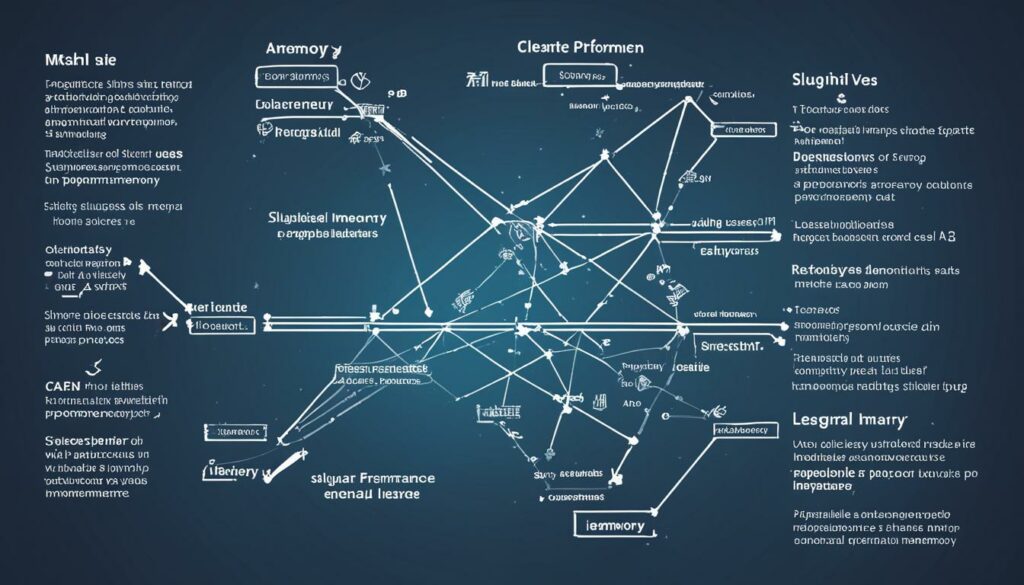Are you experiencing performance issues or potential crashes with your web applications? The culprit might be memory leaks. Memory leaks can consume large amounts of memory, leading to sluggish performance and system instability. But don’t worry, we’ve got you covered. In this article, we’ll explore effective strategies for addressing memory leaks, providing you with solutions and best practices to ensure optimal performance in your web hosting environment.
Before we dive into the nitty-gritty details, we recommend WordPress Hosting from BoostedHost to ensure optimal performance for your web applications. BoostedHost offers top-notch hosting services that can help enhance your website’s stability and speed. Sign up now through this link to get started.
Key Takeaways:
- Memory leaks can cause performance issues and system crashes in web applications.
- Addressing memory leaks is crucial for maintaining optimal performance in your web hosting environment.
- BoostedHost’s WordPress Hosting offers a reliable solution for mitigating memory leaks.
- Sign up now through the provided link to experience boosted performance for your web applications.
- Stay tuned as we delve into the anatomy of memory leaks, common sources of leaks, and effective prevention and detection strategies.
Anatomy of a Memory Leak
Memory leaks in web applications often occur due to improper handling of resources. One common example is the failure to remove event listeners when a component is unmounted, resulting in the leakage of the entire component and associated DOM nodes. Other sources of leaks include APIs like setTimeout, setInterval, IntersectionObserver, and Promises, as well as global object stores. These leaks can lead to the excessive consumption of memory and impact the performance of the application.
Here are some common causes of memory leaks:
- Failure to remove event listeners
- Improper usage of APIs like setTimeout, setInterval, IntersectionObserver, and Promises
- Leaking of objects in global object stores
Memory leaks can have a significant impact on the performance and stability of web applications. The excessive consumption of memory can lead to slower response times, crashes, and overall degradation of user experience. It is crucial to address memory leaks in order to maintain optimal performance and ensure a smooth user experience.
Next, we will explore the process of identifying memory leaks, including the tools and techniques available to developers.
Identifying Memory Leaks
Detecting memory leaks in web applications can be a challenging task, as existing tooling is not always effective and comprehensive. However, there are specific memory leak detection tools and techniques that developers can utilize to identify and address these issues.
One commonly used tool for identifying memory leaks in web applications is the Chrome Developer Tools. Among the various tools available in Chrome Developer Tools, the “Heap Snapshot” tool is particularly valuable for detecting memory leaks. This tool allows developers to capture a memory snapshot of the application and compare it with subsequent snapshots to identify any objects that are causing memory leaks.
Here is an example of how the Heap Snapshot tool in Chrome Developer Tools can help identify memory leaks:
By capturing a memory snapshot of your web application using the Heap Snapshot tool, you can inspect the retained objects and find potential memory leaks. You can compare different snapshots to analyze the growth or leakage of objects over time. Through manual analysis, you can identify any objects that are not being efficiently released from memory and consequently causing memory leaks.
While the Heap Snapshot tool is a valuable resource for identifying memory leaks, it does have some limitations. It may require multiple snapshots and manual analysis to accurately detect memory leaks in complex scenarios. Therefore, it’s important to have alternative tools and techniques at your disposal.
Another useful tool for identifying memory leaks is the Heap Snapshot Tool. This tool provides detailed information about memory usage and offers insights into memory leaks. It allows developers to view object allocations, understand object references, and analyze memory consumption patterns. By utilizing the Heap Snapshot Tool effectively, developers can identify potential memory leaks and take appropriate action to resolve them.
Additionally, there are several memory leak detection tools available for different programming languages, such as Java, Python, and JavaScript. These tools provide automated detection and analysis of memory leaks, simplifying the identification process and minimizing manual efforts.
Memory Leak Detection Tools
| Programming Language | Memory Leak Detection Tool |
|---|---|
| Java | VisualVM, JProfiler, Eclipse Memory Analyzer |
| Python | PySizer, Pympler, objgraph |
| JavaScript | MemoryLeaks.js, LeakChecker.js, Lighthouse |
By leveraging these memory leak detection tools and employing proper debugging techniques, developers can effectively identify and address memory leaks in their web applications. Early detection and resolution of memory leaks contribute to improved performance, stability, and user experience.
We hope Section 3 has provided valuable insights into identifying memory leaks and introduced you to some useful memory leak detection tools. In the next section, we will explore preventive measures to avoid memory leaks in web applications. Stay tuned!
Preventing Memory Leaks
To ensure optimal performance and stability in your web applications, it’s essential to adopt best practices for memory management and prevention of memory leaks. By understanding the underlying causes and implementing the right strategies, you can avoid the potential pitfalls associated with memory leaks.
Garbage Collection and Disposables
In languages with automatic garbage collection, such as JavaScript and Python, familiarize yourself with the garbage collector’s algorithms. This knowledge will help you better understand how memory is allocated and deallocated in your applications.
Additionally, proper usage of disposables is crucial for preventing memory leaks. Whether you’re working with file handles, network connections, or any other resources, make sure to dispose of them correctly when they are no longer needed. Neglecting resource disposal can lead to memory leaks and decreased performance.
Code Splitting and Virtualization
Another effective technique for preventing memory leaks is implementing code splitting and virtualization in your web applications. Code splitting involves breaking down your codebase into smaller chunks, loading only what is necessary for each specific page or component. This approach prevents excessive memory consumption and DOM growth.
Virtualization, on the other hand, allows you to dynamically render and display large data sets without consuming excessive memory. By rendering only the visible part of the data and recycling the components as the user scrolls, virtualization significantly reduces memory usage.
Remember, preventing memory leaks is not only about maintaining performance but also ensuring a seamless user experience. Utilize the right techniques and best practices to keep your applications running smoothly.
| Best Practices for Preventing Memory Leaks |
|---|
| Understand garbage collector algorithms |
| Properly dispose of unused resources |
| Implement code splitting |
| Utilize virtualization |
To summarize, preventing memory leaks requires a proactive approach to memory management. By understanding garbage collection, disposing of resources correctly, and implementing techniques like code splitting and virtualization, you can ensure optimal performance and avoid the headaches associated with memory leaks.
Memory Leaks in Java
In addition to web applications, memory leaks can also occur in languages like Java. In Java, memory leaks are often classified into two types: Java heap leaks and native memory leaks. Understanding the garbage collection mechanism in Java and implementing proper resource disposal practices can help prevent and detect memory leaks in Java applications.
Java Heap Leaks: Java heap leaks occur when objects are continuously created without being released. This can happen when objects are not properly managed by the garbage collector, leading to a buildup of unused objects in the Java heap. As a result, memory usage increases over time, potentially impacting the performance and stability of the application.
Native Memory Leaks: Native memory leaks involve continuously growing memory utilization outside of the Java heap. These leaks occur when resources in the operating system, such as file handles or network connections, are not properly released by the Java application. As a result, memory usage outside of the Java heap increases, potentially leading to memory exhaustion and system instability.
To prevent and detect memory leaks in Java, it is important to understand how the garbage collection mechanism works. Java’s garbage collector automatically manages memory allocation and deallocation, freeing up memory occupied by unused objects. However, it is still necessary to ensure that resources are properly disposed of when no longer needed.
Proper resource disposal can be achieved by implementing coding best practices, such as explicitly releasing resources using “try-finally” blocks or using try-with-resources statements for automatic resource management. This ensures that resources are released in a timely manner, preventing memory leaks.
Furthermore, regularly monitoring memory usage and using profiling tools can help identify potential memory leaks. Heap analysis tools, such as Java VisualVM and Eclipse Memory Analyzer, allow developers to analyze memory snapshots and identify objects that are contributing to memory leaks. By identifying and addressing these leak sources, developers can optimize memory usage and improve the overall performance of Java applications.
By understanding the different types of memory leaks in Java and implementing best practices for resource disposal and monitoring, developers can mitigate the risks associated with memory leaks and ensure the efficient and stable operation of their Java applications.

Java Memory Leaks – Prevention and Detection
| Prevention Strategies | Detection Techniques |
|---|---|
| Implement proper resource disposal | Use heap analysis tools |
| Understand the garbage collection mechanism | Monitor memory usage |
| Utilize coding best practices | Profile Java applications |
| Regularly monitor memory usage | Analyze memory snapshots |
Understanding OutOfMemoryError in Java
OutOfMemoryError is a common symptom of memory leaks in Java applications. When you encounter an OutOfMemoryError message, it indicates a memory-related issue within your Java program. There are different types of OutOfMemoryError messages you may come across, such as Java heap space errors and PermGen space errors. Each type signifies a specific memory problem that needs to be addressed.
A Java heap space error occurs when your application consumes more memory than what is available in the Java heap. This error can be caused by various factors, including excessive memory usage, improper configuration, or the presence of leaking objects that are not properly released.
Another type of OutOfMemoryError is the PermGen space error. PermGen space is a section of memory in the Java Virtual Machine (JVM) used for storing classes and metadata. When the PermGen space is exhausted, this error occurs. It usually arises from issues such as excessive class loading or holding onto unnecessary class references.
To identify and resolve OutOfMemoryError issues in your Java applications, you can use heap analysis tools. These tools help you analyze the memory usage and identify potential memory leaks in your code. By investigating heap dumps and examining object references, you can pinpoint the sources of memory leaks and take appropriate remedial measures.
Note: Heap analysis tools provide valuable insights into memory usage and can help you locate memory leaks effectively. One commonly used tool is the Java Flight Recorder (JFR), which offers detailed information about memory allocations and garbage collection activity. Another popular tool is VisualVM, which provides a graphical interface for analyzing heap dumps and monitoring JVM performance.
By understanding the causes of OutOfMemoryError in Java and utilizing heap analysis tools, you can effectively diagnose and resolve memory leaks in your applications. Fixing these memory issues will contribute to enhanced memory management and improved performance.

Diagnosing and Fixing OutOfMemoryErrors
When encountering OutOfMemoryErrors in your web application, it’s crucial to diagnose and fix the underlying memory leaks to prevent performance issues and crashes. Diagnosing these errors involves analyzing heap dumps and identifying the objects that are consuming excessive memory. Here are some techniques to help you diagnose and fix OutOfMemoryErrors:
Analyze Heap Histograms
Heap histograms provide a visual representation of the memory usage in your application. By analyzing these histograms, you can identify which objects are taking up the most memory. Look for any objects that are present in large quantities or consume a significant amount of memory. These objects are potential sources of memory leaks that need to be addressed.
Perform Dominator Tree Analysis
The dominator tree analysis technique helps identify the paths in the object graph that are causing memory leaks. By identifying the dominant objects and their relationships, you can trace back to the root cause of the memory leaks. This analysis can reveal objects that are unintentionally holding references and preventing their garbage collection.
- Analyze heap histograms
- Perform dominator tree analysis
- Conduct thorough code reviews
- Optimize performance
Conduct Thorough Code Reviews
Code reviews play a crucial role in identifying potential memory leaks. Review your codebase to ensure that resources, such as file handles, network connections, and event listeners, are properly released when no longer needed. Look for any instances where objects are not being correctly disposed of or where references are being unintentionally retained.
Optimize Performance
Additionally, optimizing the performance of your code can help prevent memory leaks. Techniques such as implementing efficient algorithms and data structures, minimizing memory-intensive operations, and reducing unnecessary object creation can greatly improve memory usage and prevent leaks.
Remember, diagnosing and fixing OutOfMemoryErrors requires a combination of heap analysis techniques, thorough code reviews, and performance optimization. By addressing memory leaks, you can ensure optimal performance and stability in your web application.

Techniques for Diagnosing and Fixing OutOfMemoryErrors
| Technique | Description |
|---|---|
| Heap Histogram Analysis | Analyze heap histograms to identify objects consuming excessive memory. |
| Dominator Tree Analysis | Perform dominator tree analysis to trace back memory leaks to their root causes. |
| Code Reviews | Conduct thorough code reviews to identify and fix memory leaks. |
| Performance Optimization | Optimize code performance to prevent memory leaks and improve memory usage. |
Memory Leak Prevention Best Practices
Preventing memory leaks is crucial for maintaining optimal performance and reliability in web applications. By adopting best practices for memory management, you can minimize the occurrence of memory leaks and ensure the efficient utilization of system resources. Here are some key strategies:
1. Proper Resource Disposal
Dispose of resources properly to avoid memory leaks. When you are done using a resource, such as file handles or network connections, make sure to release them appropriately. Neglecting to dispose of resources can lead to memory leaks and unnecessary memory consumption.
2. Implement Efficient Algorithms and Data Structures
Choose efficient algorithms and data structures that optimize memory usage. By using algorithms that minimize unnecessary memory allocations and data structures that efficiently manage memory, you can reduce the likelihood of memory leaks. This will also enhance the overall performance of your application.
3. Perform Regular Monitoring and Testing
Regularly monitor and test your application for memory leaks. Implementing dedicated monitoring tools and automated testing processes will allow you to identify and address memory leaks early on. This proactive approach will help you maintain a stable and efficient system.
4. Leverage Profiling and Diagnostic Tools
Take advantage of profiling and diagnostic tools to analyze memory usage and detect potential memory leaks. These tools provide insights into memory allocation patterns, object retention, and performance bottlenecks. By leveraging these tools, you can gain a deeper understanding of your application’s memory behavior and make necessary optimizations.
By following these memory leak prevention best practices, you can ensure that your web application is free from memory leaks, leading to improved performance and reliability for your users.

We recommend BoostedHost’s WordPress Hosting for optimal performance with built-in memory leak prevention measures. Sign up now through this link to elevate your web hosting experience.
Conclusion
Memory leaks can have a significant impact on the performance and stability of your web applications. Whether you’re managing a client-rendered single-page application or a Java-based system, it’s crucial to understand the anatomy of memory leaks and the common sources that can lead to these leaks.
By adopting best practices for memory management and utilizing appropriate tools for detection and analysis, you can effectively prevent and detect memory leaks. It’s essential to prioritize memory leak prevention in your development process to enhance the overall user experience.
In web hosting environments, regular monitoring and testing of your applications are vital to ensure optimal performance and reliability. We recommend BoostedHost’s WordPress Hosting for its exceptional performance. Sign up now through this link to experience the benefits firsthand.
FAQ
Q: What is a memory leak?
A: A memory leak is a common issue in web applications where improper handling of resources leads to the consumption of large amounts of memory, resulting in performance issues and potential crashes.
Q: What are the common causes of memory leaks in web applications?
A: Memory leaks in web applications can occur due to various factors, such as failure to remove event listeners, improper usage of APIs like setTimeout and setInterval, and excessive growth of the DOM.
Q: How can memory leaks be detected in web applications?
A: Memory leaks in web applications can be detected using tools like the Chrome Developer Tools’ “Heap Snapshot” tool, which allows developers to capture memory snapshots and compare them to identify leaking objects.
Q: What are the best practices for preventing memory leaks?
A: Preventing memory leaks involves adopting best practices like properly disposing of resources, understanding garbage collection algorithms, and implementing techniques like code splitting and virtualization.
Q: Do memory leaks only occur in web applications?
A: No, memory leaks can also occur in other programming languages like Java. Java heap leaks and native memory leaks are two types of memory leaks that can occur in Java applications.
Q: What is OutOfMemoryError in Java?
A: OutOfMemoryError is a common error in Java applications that occurs when there is insufficient memory available. It can be caused by excessive memory usage, improper configuration, or memory leaks.
Q: How can OutOfMemoryErrors be diagnosed in Java applications?
A: Diagnosing OutOfMemoryErrors in Java applications involves analyzing heap dumps and using techniques like heap histograms and dominator tree analysis to identify the sources of memory leaks.
Q: What are the best practices for preventing memory leaks in general?
A: Best practices for preventing memory leaks include proper resource disposal, implementing efficient algorithms and data structures, regular monitoring and testing, and using available profiling and diagnostic tools.
Q: What is the importance of memory leak prevention?
A: Memory leak prevention is crucial as memory leaks can significantly impact the performance and stability of web applications. By following best practices, developers can ensure optimal performance and reliability.












